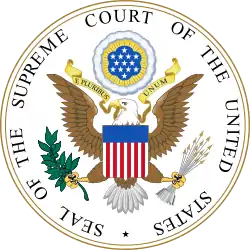Collins v. Mnuchin
Collins v. Mnuchin is a pending United States Supreme Court case dealing with the structure of the Federal Housing Finance Agency (FHFA). The case follows on the Court's prior ruling in Seila Law LLC v. Consumer Financial Protection Bureau,[1] which found that the establishing structure of the Consumer Financial Protection Bureau (CFPB), with a single director who could only be removed from office "for cause", violated the separation of powers; the FHFA shares a similar structure as the CFPB. The case extends the legal challenge to the federal takeover of Fannie Mae and Freddie Mac in 2008.
| Collins v. Mnuchin | |
|---|---|
 | |
| Argued December 9, 2020 | |
| Full case name | Patrick J. Collins, et al., v. Steven T. Mnuchin, Secretary of the Treasury, et al. |
| Docket no. | 19-422 |
| Case history | |
| Prior | |
| Court membership | |
| |
Background
Part of the contributing factors to the subprime mortgage crisis from 2007 to 2010 was the role of Fannie Mae and Freddie Mac, for-profit government sponsored enterprises (GSE) that purchase mortgages and backed almost half of the mortgages in the United States. Analysis had found that the two GSEs had purchased a number of risky mortgages, those offered at below the prime interest rate as to encourage home ownership, during the housing market peak in 2005 and 2006 and represented a large risk should they fail. At the start of the crisis, the rationalization of the number of these low-interest mortgages disrupted the banking system, causing some larger banks to go into bankruptcy or seek means to avoid this, which disrupted the credit system and further exacerbated the crisis and caused a recession.[2]
Congress passed the Housing and Economic Recovery Act of 2008[3] in July of that year to try to stave off the effects of the recession. Among the law's goals included the formation of the Federal Housing Finance Agency (FHFA), merging the existing Federal Housing Finance Board (FHFB) and Office of Federal Housing Enterprise Oversight (OFHEO). The new FHFA was run by a single Director, with James B. Lockhart III, the prior Director of OFHEO, named to the initial position. In September 2008, Lockhart issued an order to bring in Fannie Mae and Freddie Mac under FHFA's authority for the purposes of stabilizing both GSEs using funds allocated by Congress as a means to alleviate the mortgage crisis.[2]
As part of this takeover, once the mortgage crisis was subdued in 2012, the FHFA routed the ongoing profits earned by Fannie Mae and Freddie Mac to the Treasury Department on the basis that these funds were needed to offset the taxpayers' costs of the government's intervention to resolve the crisis. The decision also prevents both GSEs from using Treasury funds to pay their shareholders. Shareholders of both companies challenged the government's actions, stating that these decisions prevents the company from building capital and is excessive governmental overreach.[4]
As the case progressed, the Supreme Court heard Seila Law LLC v. Consumer Financial Protection Bureau.[1] In this case, the structure of the Consumer Financial Protection Bureau (CFPB) was called into question. Like FHFB, the CFPB was formed by legislation passed by Congress, and specified that it was to be overseen by a single Director that can only be removed from office "for cause" and did not give the option for the President to remove the person "at will". The Supreme Court agreed that this structure was unconstitutional as it violated the separation of powers between the executive and legislative branches. The Supreme Court ruled that the Director position of CFPB must be also removable by will, but otherwise did not challenge the function of the CFPB since they had found its purpose to be severable from the implementation of the Director position.[5]
Seila Law was concurrently progressing through lower courts at the same time as Collins. Seila Law had been heard in the Ninth Circuit, which had ruled that the structure of the CFPB was constitutional.[6] Collins was heard in the Fifth Circuit, which ruled both on its initial three-judge panel[7] and at an en banc hearing[8] that the FHFB was unconstitutional.
Both sides of Collins petitioned to the Supreme Court in 2019 to hear the case; the shareholders sought to resolve the split in the Circuit Courts as well as to question whether any decisions - including the profit taking decision 2012 - made under the unconstitutional structure should be reversed, while the government challenged the Fifth Circuit's ruling. Following the ruling in Seila Law issued in June 2020, the Supreme Court certified the case.
Supreme Court
Oral hearings for the case were held on December 9, 2020.[4]
References
- Seila Law LLC v. Consumer Financial Protection Bureau, No. 19-7, 591 U.S. ___ (2020).
- "Credit and blame: A must-read on the origins of the crisis". The Economist. 2008-09-11. Retrieved 2008-09-11.
- Pub.L. 110–289 (text) (pdf), H.R. 3221, 122 Stat. 2654, enacted July 30, 2008.
- Ackerman, Andrew; Kendall, Brent (December 9, 2020). "Supreme Court Weighs U.S. Profit Sweep at Fannie, Freddie". The Wall Street Journal. Retrieved December 9, 2020.
- Mangan, Dan; Higgens, Tucker (June 29, 2020). "Supreme Court leaves consumer regulator standing but backs president's ability to fire director". CNBC. Archived from the original on June 29, 2020. Retrieved June 29, 2020.
- Consumer Financial Protection Bureau v. Seila Law LLC, 923 F.3d 680 (9th Cir. 2019).
- Collins v. Mnuchin, 896 F.3d 640 (5th Cir. 2018).
- Collins v. Mnuchin, 938 F.3d 553 (5th Cir. 2019).
External links
- Text of Collins v. Mnuchin, No. 19-422 is available from: Oyez (oral argument audio)